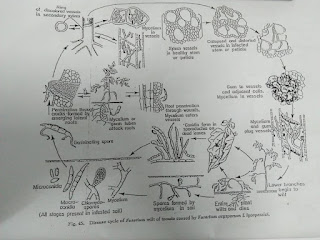Practical 5
HIGHER FUNGI –
TAXANOMY AND PATHOLOGICAL IMPORTANCE ( PHYLUM ASCOMYCOTA )
The
phylum Ascomycota are well developed fungi. The Hemiascomycetes comprising the
yeast are unicellular, but all other classes produced hyphae that are septate.
Most are identified from the type of conidium ( asexual spore ) that are
commonly produced. They may be openly attached on conidiospores, or are
contained within fruiting structure such as pycnidium ( closed ) or the
acervulus. Where sexual reproduction occurs, several types of fruiting body (
called the ascocarps ) are formed, that may be closed and rounded (
cleisthothecium ), closed with ostiole ( perithecium ), saucer shaped (
apothecium ) or cushioned shaped with locules ( ascostroma ). The ascocarp contain
ascus bearing the ascospores ( sexual spores ) that are usually 8 in number.
Order Agonomycetales in the class Deutromycetes consists of fungi bearing
neither asexual nor sexual spores. The hyphe are sterile but are known to
produce sclerotium ( small and roundish hyphal aggregations )
EXERCISE
A.
FUNGAL CULTURE
Pure cultures of Penicillium
sp, Chaetomium sp, and Fusarium sp , Curvularia sp are provided. Make temporary slides and examine for
presence of asexual stage e.g. conidium or sexual stages.
B.
Plants disease specimens
1.
Powdery mildew
of rubber
Caused by Oidium
heveae. Infect young leaves of rubber causing massive leaf fall. Fungus also
lives on mature leaves throughout the year.
2.
False smut of
padi
Caused by Ustilaginoidea virens. Infects rice at
the following stage producing symptoms of yellowish green fungal growth on
seeds.
3.
Citrus scab
Caused by Elsinoe fawcetti. Infects leaves, fruits
and stems of citrus. Symptoms of corky lesions and causing abnormal leaf shape.
4.
Leaf blight of
maize/corn
Caused by Drechslera maydis
5.
Sigatoka disease
of banana
Caused by Mycosphaerella musicola ( telemorph ) Cercospora musae ( anamorph )
6.
Moldy rot of
rubber
Caused by Ceratocystis fimbriata. Infects tapping
panel of rubber.
7.
South American
Leaf Blight ( SALB ) of rubber
Caused by Microcyclus ulei. This disease occurs
only in South America and is unknown in rubber grown in Asia.
8.
Sooty mould
disease
Caused more than one
fungi : Tripospermum sp, Capnodium sp, Limacinula sp. Infects various crop such as fruit tree. Symptoms mainly of blackish layer of
fungal growth on leaves and other part plants.
9.
Black mildew
Caused by Meliola sp. Similar with sooty mould
disease but fungus forms scattered, blackish growths instead of layers mainly
on leaves of mango and other fruit tree.
10. Blast of paddy
Caused by Pyricularia oryzae ( anamorph ) / Magnaporthe grisea ( teleomorph ).
Infects paddy causing deaths in seedling. Typical symptom is the diamond shaped
spot on paddy leaves.
11. Brown spot of paddy
Caused by Drechslera oryzae. Typical symptom is
the rounded shaped brown spots on paddy leaves.
12. Narrow brown leaf spot of paddy
A minor disease caused
by Cercospora oryzae. Symptom as in
the name of disease.
13. Sheath blight of paddy
Caused by Rhizoctonia solani. Cause blakish
lesions on leaf sheaths and stems. Fungus form sclerotia.
14. Foot rot
Caused by Sclerotium rolfsii. Infects many vegetable
crop such as brinjal, chilli, tomato and groundnuts. Cause rots at the base of
the stems identified by the whitish growth ( rhizomorphs ) of the fungus.
Fungus forms sclerotia.
15. Antrachnose
Caused by differenct
species :
Chilli : Colletotrichum capsici
French bean/kacang
buncis : C. dematium , C. truncatum
Mango
/papaya/rubber/cocoa :C. gloeosporioides
Banana : C. musae
16. Bird eye spot disease
Caused by Drechslera
heveae. Symptoms on leaves as suggested by name of disease.
17. Leaf spot disease
Caused by Pestalotiopsis sp. Infects various crops
of mainly palms such as coconuts, oil palm and ornamental palms. Leaf spots can
be identified by presence of blackish acervulus.
18. Panama disease or banana wilt
Caused by Fusarium oxysporum f.sp. cubensis. Major disease of banana world
wide causing wilt and death of plants.
C.
1.
Saccharomyces cerevisiae.
Unicellular, yeast cell
in class Hemiascomycetes
2.
Penicillium sp, Aspergillus sp.
Conidia form on this
species. Generally, Penicillium form phiallides which are brushlike while
conidia are produced on sterigmata on conidial head in Aspergillus sp
3.
Meliola sp.
Observe the hypodia,
short branches of hyphae used to absorb nutrients from leaf surfaces.
4.
Class
Deuteromyctes
Order Moniliales:
Observe and identify fungus based on different shapes of
conidia of different genus such as Alternaria, Curvularia, Cerospora and
others.
5.
Morchella sp
Example of class
Discomycetes that produce apothecium
6.
Order Melanconiales.
Conidia formed within
an acervulus.
Example : Colletotrichum
capsisi is sickle shaped like conidia and Colletotrichum gloeosporioides is rod shaped conidia. The genus
Pestalotiopsis is also in this group.
7.
Order sphaeropsidales:
Conidia formed within an pycnidium
Example: Septoria, Phoma,
8.
Order
Agnomycetales:
Steril mycelium and production of
scloretia
Example: Rhizoctoniz sp and Sclerotium sp.
D.
Disease cycle
1.
Mycosphaerella musicola
2.
Bipolaris ( helminthosporium) maydis
3.
Rhizoctonia solani
4.
Sphaerotheca pannosa
5.
Fusarium oxysporium



























No comments:
Post a Comment